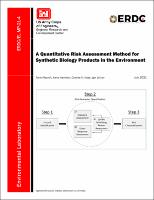Please use this identifier to cite or link to this item:
https://hdl.handle.net/11681/41331| Title: | A quantitative risk assessment method for synthetic biology products in the environment |
| Authors: | Rycroft, Taylor E. Haas, Charles N. Linkov, Igor Hamilton, Kerry |
| Keywords: | Synthetic biology Risk assessment Environmental health and safety |
| Publisher: | Environmental Laboratory (U.S.) Engineer Research and Development Center (U.S.) |
| Series/Report no.: | Miscellaneous Paper (Engineer Research and Development Center (U.S.)) ; no. ERDC/EL MP-21-4 |
| Is Version Of: | Rycroft, Taylor, Kerry Hamilton, Charles N. Haas, and Igor Linkov. "A quantitative risk assessment method for synthetic biology products in the environment." Science of the Total Environment 696 (2019): 133940. https://doi.org/10.1016/j.scitotenv.2019.133940 |
| Abstract: | The need to prevent possible adverse environmental health impacts resulting from synthetic biology (SynBio) products is widely acknowledged in both the SynBio risk literature and the global regulatory community. However, discussions of potential risks of SynBio products have been largely speculative, and the attempts to characterize the risks of SynBio products have been non-uniform and entirely qualitative. As the discipline continues to accelerate, a standardized risk assessment framework will become critical for ensuring that the environmental risks of these products are characterized in a consistent, reliable, and objective manner that incorporates all SynBio-unique risk factors. Current established risk assessment frameworks fall short of the features required of this standard framework. To address this, we propose the Quantitative Risk Assessment Method for Synthetic Biology Products (QRASynBio) – an incremental build on established risk assessment methodologies that supplements traditional paradigms with the SynBio risk factors that are currently absent and necessitates quantitative analysis for more transparent and objective risk characterizations. The proposed framework facilitates defensible quantification of the environmental risks of SynBio products in both foreseeable and hypothetical use scenarios. Additionally, we show how the proposed method can promote increased experimental investigation into the likelihood of hazard and exposure parameters and highlight the parameters where uncertainty should be reduced, leading to more targeted risk research and more precise characterizations of risk. |
| Description: | Miscellaneous Paper |
| Gov't Doc #: | ERDC/EL MP-21-4 |
| Rights: | Approved for Public Release; Distribution is Unlimited |
| URI: | https://hdl.handle.net/11681/41331 http://dx.doi.org/10.21079/11681/41331 |
| Appears in Collections: | Miscellaneous Paper |
Files in This Item:
| File | Description | Size | Format | |
|---|---|---|---|---|
| ERDC-EL MP-21-4.pdf | 1.76 MB | Adobe PDF |  View/Open |